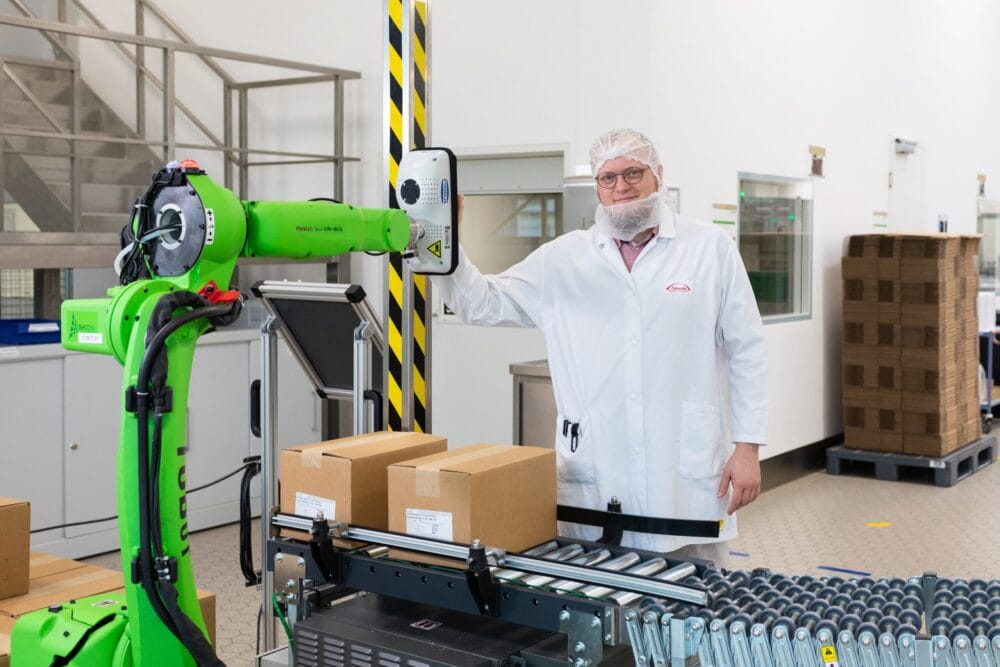A cobot solution from FANUC and system integrator SKDK is alleviating health and safety issues at a German pharmaceutical manufacturing facility by working collaboratively with human employees to pack and stack packets of tablets onto pallets. Prior to the cobot’s installation, workers at the Takeda Pharmaceutical Company in Oranienburg, Germany were physically moving loads totalling 5.8 tonnes per shift, resulting in numerous days lost to sickness. Since the introduction of the FANUC CR-15iA, productivity has improved considerably, with the cobot working 24/7 while meeting all health and safety requirements.

The cobot solution is alleviating health and safety issues by working collaboratively with human employees to pack and stack packets of tablets onto pallets
Japanese bio-pharmaceutical pioneer Takeda Pharmaceutical Company has a presence in over 80 regions. As a key part of its global production network, its drug manufacturing facility in Oranienburg produces more than six billion tablets and capsules each year. This significant number of drugs is required to be order picked at the end of each production line and placed onto pallets ready for shipment – back-breaking work averaging a weight of 5.8 tonnes per shift, from which the company was keen to relieve its workers.
Promoting collaboration
But while Takeda sought to delegate the heavy lifting to a robot counterpart, it also wanted to ensure its human workforce did not feel that their roles would be threatened by an automated alternative. “We involved the workers as early and intensively as possible,” explains Takeda Project Manager Robert Gundlach, who knew from experience in other projects that success depends on acceptance by staff. For the people based on the assembly line, this meant more informational events across shifts, in which the technology and planned implementation were explained in detail. “It was made clear to people that a robot is nothing more than a stepping stone to make work easier. We sold the robots as new colleagues, not as new technology.”
A big plus for the CR-15iA in this regard, is the fact that it does not need to be ‘hidden’ behind a fence. Without the need for a cage, workers’ reservations were reduced. “Staff can go within touching distance of our collaborative robots,” adds Sebastian Steinbach, who supported the project on site for FANUC. “This made the introduction of new technology more readily acceptable.”
Faultless operation
Takeda’s human employees now successfully work side-by-side with their cobot colleague, letting it take the physical strain of their role. Small glass bottles filled with tablets are packaged in multiple cartons, which are moved to the packing table by two workers, five packs at a time, and set in a box. The cobot scans the label, then grabs the box from the conveyor belt and stacks it onto the shipping pallet with the label facing outwards, in a configuration of eight boxes per layer and four layers high. With a reach of 1,441 mm and a maximum load capacity of 15kg, the cobot fulfils this task effortlessly, working 24/7 – around 8,000 packages have already been processed since its installation, and the system has run without a hitch.
Meeting demanding hygiene standards
Of course, hygiene is also a key factor in any purchasing decision for a pharmaceutical company, and to this end, the FANUC CR-15iA more than meets this demand. Its extra smooth surfaces help to minimise dust and dirt build up, and with IP67-protection on its arm and wrist axis, it is well suited for environments where the highest standards of hygiene are required.
The success of this collaborative cell, installed by Berlin-based system integrator and FANUC partner SKDK, is now serving as a template for all packing stations in the facility and has inspired other Takeda sites to examine the use of robots, too. “There is already a wish-list for further robot projects,” enthuses Robert Gundlach.









